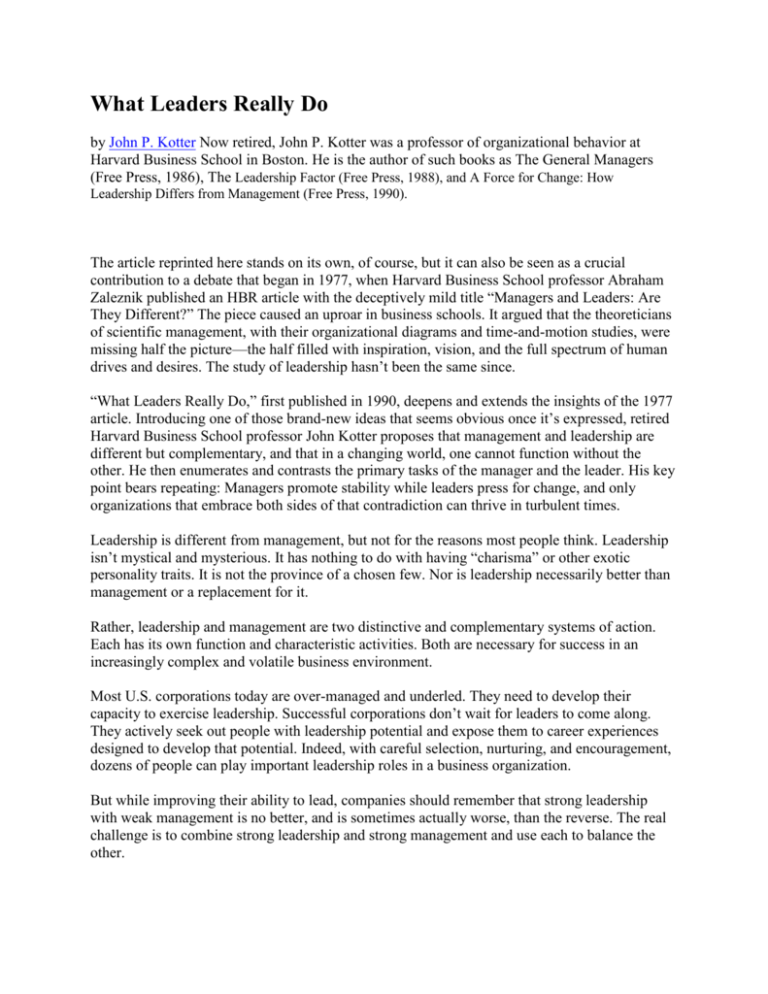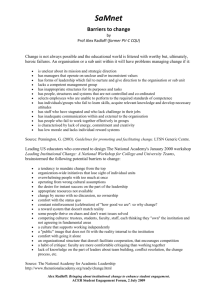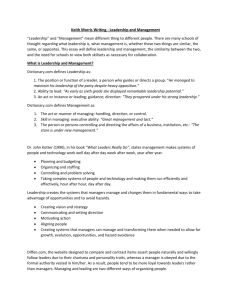Handouts 1
advertisement

What Leaders Really Do by John P. Kotter Now retired, John P. Kotter was a professor of organizational behavior at Harvard Business School in Boston. He is the author of such books as The General Managers (Free Press, 1986), The Leadership Factor (Free Press, 1988), and A Force for Change: How Leadership Differs from Management (Free Press, 1990). The article reprinted here stands on its own, of course, but it can also be seen as a crucial contribution to a debate that began in 1977, when Harvard Business School professor Abraham Zaleznik published an HBR article with the deceptively mild title “Managers and Leaders: Are They Different?” The piece caused an uproar in business schools. It argued that the theoreticians of scientific management, with their organizational diagrams and time-and-motion studies, were missing half the picture—the half filled with inspiration, vision, and the full spectrum of human drives and desires. The study of leadership hasn’t been the same since. “What Leaders Really Do,” first published in 1990, deepens and extends the insights of the 1977 article. Introducing one of those brand-new ideas that seems obvious once it’s expressed, retired Harvard Business School professor John Kotter proposes that management and leadership are different but complementary, and that in a changing world, one cannot function without the other. He then enumerates and contrasts the primary tasks of the manager and the leader. His key point bears repeating: Managers promote stability while leaders press for change, and only organizations that embrace both sides of that contradiction can thrive in turbulent times. Leadership is different from management, but not for the reasons most people think. Leadership isn’t mystical and mysterious. It has nothing to do with having “charisma” or other exotic personality traits. It is not the province of a chosen few. Nor is leadership necessarily better than management or a replacement for it. Rather, leadership and management are two distinctive and complementary systems of action. Each has its own function and characteristic activities. Both are necessary for success in an increasingly complex and volatile business environment. Most U.S. corporations today are over-managed and underled. They need to develop their capacity to exercise leadership. Successful corporations don’t wait for leaders to come along. They actively seek out people with leadership potential and expose them to career experiences designed to develop that potential. Indeed, with careful selection, nurturing, and encouragement, dozens of people can play important leadership roles in a business organization. But while improving their ability to lead, companies should remember that strong leadership with weak management is no better, and is sometimes actually worse, than the reverse. The real challenge is to combine strong leadership and strong management and use each to balance the other. Of course, not everyone can be good at both leading and managing. Some people have the capacity to become excellent managers but not strong leaders. Others have great leadership potential but, for a variety of reasons, have great difficulty becoming strong managers. Smart companies value both kinds of people and work hard to make them a part of the team. But when it comes to preparing people for executive jobs, such companies rightly ignore the recent literature that says people cannot manage and lead. They try to develop leader-managers. Once companies understand the fundamental difference between leadership and management, they can begin to groom their top people to provide both. The Difference Between Management and Leadership Management is about coping with complexity. Its practices and procedures are largely a response to one of the most significant developments of the twentieth century: the emergence of large organizations. Without good management, complex enterprises tend to become chaotic in ways that threaten their very existence. Good management brings a degree of order and consistency to key dimensions like the quality and profitability of products. Leadership, by contrast, is about coping with change. Part of the reason it has become so important in recent years is that the business world has become more competitive and more volatile. Faster technological change, greater international competition, the deregulation of markets, overcapacity in capital-intensive industries, an unstable oil cartel, raiders with junk bonds, and the changing demographics of the work-force are among the many factors that have contributed to this shift. The net result is that doing what was done yesterday, or doing it 5% better, is no longer a formula for success. Major changes are more and more necessary to survive and compete effectively in this new environment. More change always demands more leadership.











